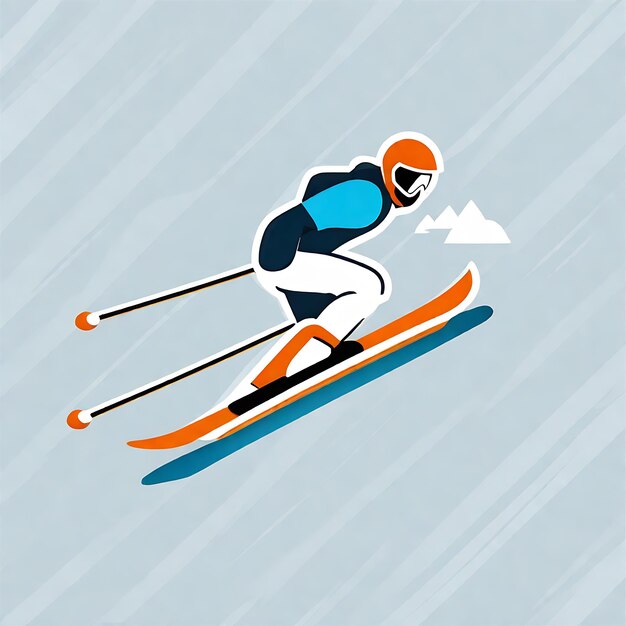Cross-training is an essential component of any skier’s training regimen. While skiing itself is a fantastic workout that targets various muscle groups, incorporating other sports and exercises into your routine can greatly enhance your overall fitness and performance on the slopes. Cross-training helps to improve strength, endurance, balance, and agility, all of which are crucial for skiing.
One of the main benefits of cross-training for skiers is the reduction of the risk of injury. Skiing puts a significant amount of stress on the body, particularly the knees and ankles. By engaging in other activities that strengthen these areas, such as yoga or strength training, skiers can help prevent common injuries like ACL tears or sprained ankles.
Additionally, cross-training helps to improve overall fitness levels. Skiing requires a combination of cardiovascular endurance, muscular strength, and flexibility. By participating in other sports and exercises that target these areas, skiers can improve their overall fitness and performance on the slopes.
Key Takeaways
- Cross-training is important for skiers to improve their overall fitness and prevent injuries.
- Cross-training benefits skiing by improving endurance, strength, balance, and agility.
- Top cross-training sports for skiers include yoga, pilates, running, cycling, swimming, and strength training.
- Yoga and pilates strengthen the core for better skiing, while running and cardio improve endurance on the slopes.
- Cycling builds leg strength and stamina, swimming enhances breathing and balance, and strength training develops power and agility for skiing.
The Benefits of Cross-Training for Skiing
1. Improved overall fitness: Cross-training allows skiers to target different muscle groups and improve their overall fitness levels. By engaging in activities like running or swimming, skiers can improve their cardiovascular endurance. This increased endurance translates to better stamina on the slopes, allowing skiers to ski for longer periods without feeling fatigued.
2. Reduced risk of injury: As mentioned earlier, cross-training helps to strengthen the muscles and joints that are most susceptible to injury while skiing. By incorporating exercises that target these areas, such as yoga or Pilates, skiers can reduce their risk of common skiing injuries.
3. Enhanced skiing performance: Cross-training helps to improve specific skills that are essential for skiing, such as balance and agility. By participating in activities like cycling or agility drills, skiers can develop these skills and ultimately enhance their performance on the slopes.
4. Increased endurance and stamina: Skiing is a physically demanding sport that requires a high level of endurance and stamina. By engaging in activities that improve cardiovascular fitness, such as running or swimming, skiers can increase their endurance and stamina, allowing them to ski for longer periods without feeling fatigued.
Top Cross-Training Sports for Skiers
1. Yoga: Yoga is an excellent cross-training activity for skiers as it helps to improve flexibility, balance, and core strength. The various poses and movements in yoga target the muscles used in skiing, such as the quadriceps, hamstrings, and core. Additionally, yoga helps to improve body awareness and mindfulness, which can be beneficial for skiers looking to improve their technique and control on the slopes.
2. Pilates: Pilates is another great cross-training activity for skiers as it focuses on core strength, stability, and flexibility. The exercises in Pilates target the deep abdominal muscles, which are essential for maintaining proper posture and balance while skiing. Additionally, Pilates helps to improve overall body strength and control, which can enhance skiing performance.
3. Running: Running is an excellent cardiovascular exercise that helps to improve endurance and stamina. It targets the muscles used in skiing, such as the quadriceps and calves, and helps to strengthen the joints in the lower body. Incorporating running into your cross-training routine can greatly enhance your overall fitness and performance on the slopes.
Yoga and Pilates: Strengthening Your Core for Better Skiing
| Exercise | Description | Benefits |
|---|---|---|
| Plank | Hold a push-up position with arms straight and abs tight | Strengthens core, arms, and shoulders |
| Side Plank | Hold a plank position on one arm with the other arm extended towards the ceiling | Strengthens obliques and improves balance |
| Bicycle Crunches | Lie on your back with knees bent and alternate touching your elbow to the opposite knee | Targets abs and obliques |
| Leg Raises | Lie on your back with legs straight and lift them up towards the ceiling | Strengthens lower abs and hip flexors |
| Bridge | Lie on your back with knees bent and lift your hips up towards the ceiling | Strengthens glutes and lower back |
Yoga and Pilates are both excellent cross-training activities for skiers as they focus on strengthening the core muscles. The core muscles play a crucial role in skiing as they help to maintain balance, stability, and control on the slopes.
In yoga, specific poses like boat pose or plank pose target the core muscles, including the abdominals, obliques, and lower back. These poses help to improve core strength and stability, which are essential for maintaining proper posture and balance while skiing. Additionally, yoga helps to improve flexibility, which can enhance your range of motion while skiing.
In Pilates, exercises like the hundred or the teaser target the deep abdominal muscles, which are responsible for maintaining core stability. These exercises help to strengthen the core muscles and improve overall body control, which can greatly enhance skiing performance. Pilates also focuses on proper breathing techniques, which can help skiers improve their breathing and endurance on the slopes.
Running and Cardio: Improving Your Endurance on the Slopes
Running and other cardiovascular exercises are essential for skiers as they help to improve endurance and stamina. Skiing is a physically demanding sport that requires a high level of cardiovascular fitness in order to ski for extended periods without feeling fatigued.
Running is an excellent cardiovascular exercise that targets the muscles used in skiing, such as the quadriceps and calves. It helps to strengthen these muscles and improve their endurance, allowing skiers to ski for longer periods without feeling tired. Additionally, running helps to improve lung capacity and oxygen uptake, which can enhance overall performance on the slopes.
Other cardio exercises like cycling or swimming can also be beneficial for skiers. Cycling helps to build leg strength and stamina, while swimming improves lung capacity and enhances breathing techniques. Incorporating these activities into your cross-training routine can greatly improve your endurance and stamina on the slopes.
Cycling: Building Leg Strength and Stamina for Skiing

Cycling is an excellent cross-training activity for skiers as it helps to build leg strength and stamina. Skiing requires strong leg muscles, particularly the quadriceps and calves, in order to maintain balance and control on the slopes.
Cycling targets these muscles and helps to strengthen them, allowing skiers to have better control over their movements while skiing. Additionally, cycling is a low-impact exercise that is easy on the joints, making it a great option for skiers who may have joint issues or injuries.
To incorporate cycling into your cross-training routine, you can either ride outdoors or use a stationary bike at the gym. Aim for at least 30 minutes of cycling, three to four times a week, gradually increasing the duration and intensity as your fitness improves. Cycling uphill or incorporating interval training can also help to further build leg strength and stamina.
Swimming: Enhancing Your Breathing and Balance for Skiing
Swimming is another excellent cross-training activity for skiers as it helps to enhance breathing techniques and improve balance. Skiing requires proper breathing techniques in order to maintain endurance and stamina on the slopes.
Swimming helps to improve lung capacity and teaches proper breathing techniques, which can be beneficial for skiers looking to improve their breathing and endurance while skiing. Additionally, swimming is a low-impact exercise that targets the muscles used in skiing, such as the shoulders, back, and core.
To incorporate swimming into your cross-training routine, aim for at least 30 minutes of swimming, three to four times a week. Focus on different strokes like freestyle or butterfly to target different muscle groups. Additionally, incorporating drills like kicking or using a kickboard can help to further enhance leg strength and balance.
Strength Training: Developing Power and Agility for Skiing
Strength training is an essential component of any skier’s cross-training routine as it helps to develop power and agility. Skiing requires explosive power in order to make quick turns and navigate through challenging terrain.
Strength training exercises like squats, lunges, deadlifts, and plyometric exercises help to build lower body strength and power, which are crucial for skiing. These exercises target the muscles used in skiing, such as the quadriceps, hamstrings, glutes, and calves. Additionally, strength training helps to improve overall body strength and stability, which can enhance skiing performance.
To incorporate strength training into your cross-training routine, aim for two to three sessions per week, focusing on different muscle groups each session. Start with lighter weights and gradually increase the intensity as your strength improves. It’s important to maintain proper form and technique while performing strength training exercises to prevent injury.
Agility and Balance Exercises: Improving Your Control and Precision on the Slopes
Agility and balance exercises are crucial for skiers as they help to improve control and precision on the slopes. Skiing requires quick reflexes and the ability to maintain balance in various positions.
Exercises like agility ladder drills, cone drills, or single-leg balance exercises help to improve agility, balance, and coordination. These exercises target the muscles used in skiing, such as the quadriceps, hamstrings, glutes, and core. Additionally, agility and balance exercises help to improve body awareness and control, which can greatly enhance skiing performance.
To incorporate agility and balance exercises into your cross-training routine, aim for two to three sessions per week. Start with simple exercises and gradually increase the difficulty as your skills improve. It’s important to focus on proper form and technique while performing these exercises to maximize their effectiveness.
Putting It All Together: Creating a Cross-Training Plan for Skiers
Creating a cross-training plan for skiing involves incorporating a variety of sports and exercises that target different muscle groups and skills. Here are some tips for creating an effective cross-training plan:
1. Set specific goals: Determine what areas you want to improve in your skiing performance, whether it’s endurance, strength, balance, or agility. This will help you choose the appropriate cross-training activities.
2. Mix it up: Incorporate a variety of sports and exercises into your routine to target different muscle groups and skills. This will help prevent boredom and keep you motivated.
3. Schedule your workouts: Set aside specific days and times for your cross-training workouts. Consistency is key to seeing progress and improving your skiing performance.
4. Start slow and progress gradually: If you’re new to cross-training, start with lighter weights or shorter durations and gradually increase the intensity or duration as your fitness improves.
5. Listen to your body: Pay attention to how your body feels during and after each workout. If you experience pain or discomfort, adjust your routine or seek guidance from a professional.
In conclusion, cross-training is an essential component of any skier’s training regimen. It helps to improve overall fitness, reduce the risk of injury, enhance skiing performance, and increase endurance and stamina. By incorporating activities like yoga, Pilates, running, cycling, swimming, strength training, agility and balance exercises into your routine, you can greatly enhance your skiing skills and performance on the slopes. Remember to create a cross-training plan that is tailored to your specific goals and abilities, and to prioritize consistency and progression in your workouts.
If you’re looking to improve your skiing skills, you might be interested in exploring other sports that can complement your winter adventures. One such sport is paddleboarding, which not only provides a great workout but also helps with balance and core strength – two essential elements for successful skiing. In fact, a recent article on Off to Sports highlights the benefits of paddleboarding for skiers, explaining how it can enhance your overall performance on the slopes. To learn more about this exciting crossover between water and snow sports, check out the article on Off to Sports.
Can Stick Sports Help Improve Your Skiing Skills Through Cross-Training?
Engaging in the thrilling world of stickbased sports can enhance your skiing skills through effective cross-training. Sports like hockey or lacrosse build core strength, balance, and agility, which are essential for navigating slopes with precision. By sharpening reflexes and improving coordination, these activities transfer seamlessly to the dynamic demands of skiing.





